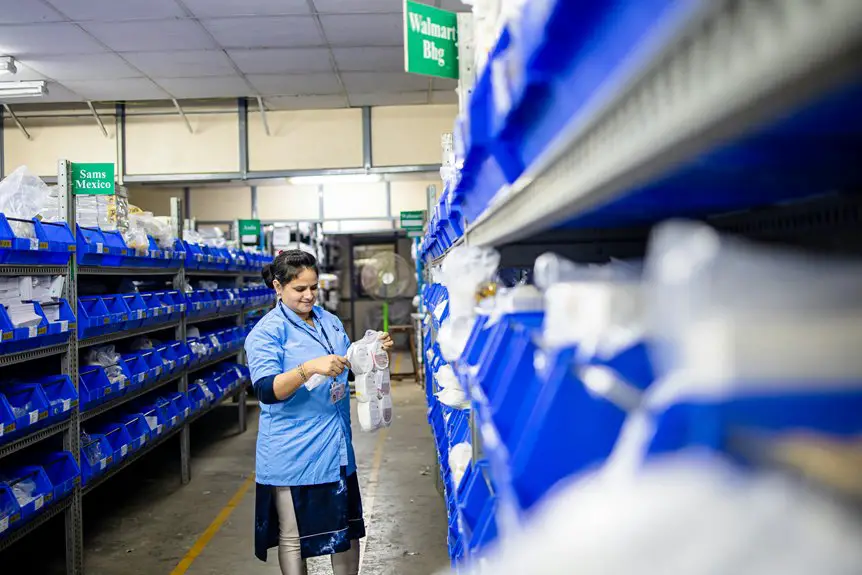In the world of remote work, packaging and labeling jobs can offer a revitalizing alternative to traditional employment. However, maneuvering through this field requires a sharp eye and a cautious approach. You might find opportunities that seem too good to be true, but knowing how to spot genuine listings can make all the difference. So, what steps can you take to guarantee you’re on the right path? Let’s explore the essentials together.
Table of Contents
Key Takeaways
- Research potential employers through job boards and company reviews to verify legitimacy before applying for packaging and labeling jobs.
- Look for clear job descriptions and responsibilities to ensure the role matches your skills and expectations.
- Avoid scams by steering clear of job listings that promise high pay for minimal work or ask for upfront payments.
- Utilize reputable job platforms like Indeed, Glassdoor, and LinkedIn, and check company careers pages for legitimate openings.
- Create a dedicated workspace at home to enhance productivity and minimize distractions while working on packaging and labeling tasks.
Understanding Packaging and Labeling Jobs
When you think about packaging and labeling jobs, you might envision assembly lines or warehouses, but these roles can also be done from the comfort of your home.
Fundamentally, packaging and labeling jobs involve preparing products for shipment and ensuring they’re correctly labeled for customers. You’ll often need to assemble boxes, pack items securely, and apply labels accurately. Attention to detail is essential, as errors can lead to customer dissatisfaction or returns.
Packaging and labeling jobs require precision in preparing and labeling products, as attention to detail is crucial for customer satisfaction.
These jobs may require basic tools and materials, which you can easily manage in your workspace. Flexibility is another perk; you can choose your hours, making it easier to balance personal commitments while earning an income.
Embrace the opportunity to work independently and efficiently!
Identifying Legitimate Opportunities
As you search for legitimate packaging and labeling jobs from home, it’s crucial to be vigilant and discerning.
Here are a few tips to help you identify genuine opportunities:
- Research the Company: Look for reviews and ratings on job boards and company websites to gauge credibility.
- Verify Job Descriptions: Legitimate jobs should clearly outline responsibilities, pay, and required skills without vague language.
- Check for Contact Information: Real companies provide clear contact details; be cautious of those that don’t.
Common Scams to Avoid
When searching for packaging and labeling jobs from home, you need to watch out for common scams.
Fake job listings often promise high pay for little work, while some might ask for upfront payments before you start.
Stay alert to protect yourself and your finances.
Fake Job Listings
While searching for packaging and labeling jobs from home, it’s crucial to stay vigilant against fake job listings that can waste your time and money.
Scammers often disguise themselves as legitimate companies, making it essential to know what to look out for. Here are some common red flags:
- Unprofessional Communication: Poor grammar, vague job descriptions, or generic emails can indicate a scam.
- Too Good to Be True: If the pay seems excessively high for minimal work, it’s likely a ploy to lure you in.
- Lack of Company Information: Legitimate employers will provide clear contact details and a professional website.
Upfront Payment Requests
One of the most common scams to watch out for in the packaging and labeling job market is the demand for upfront payments. Legitimate employers won’t ask you to pay any fees before you start working. If a job requires you to send money for materials or training, it’s a red flag.
| Warning Signs | What They Might Say | Your Response |
|---|---|---|
| Request for upfront fees | “Pay for your starter kit now!” | “I won’t pay until I start.” |
| Pressure to act fast | “Limited spots available!” | “I need more time to decide.” |
| Unprofessional communication | “Send money via wire transfer!” | “I prefer secure payment methods.” |
Stay cautious, and trust your instincts to avoid falling victim to these scams.
Where to Find Genuine Job Listings
Finding genuine job listings for packaging and labeling positions can feel overwhelming, especially with so many opportunities that may not be legitimate.
To streamline your search, focus on these reliable sources:
- Job Boards: Websites like Indeed, Glassdoor, and LinkedIn often feature verified listings.
- Company Websites: Directly visit the careers page of companies known for packaging and labeling services.
- Freelance Platforms: Explore sites like Upwork or Fiverr where businesses frequently post legitimate gig opportunities.
Essential Skills and Tools for Success
Securing a position in packaging and labeling not only requires finding the right job listings but also possessing specific skills and tools that can set you apart from the competition.
You’ll need strong attention to detail to guarantee accuracy in labeling and packaging. Familiarity with design software, like Adobe Illustrator or Canva, can help you create eye-catching labels.
Additionally, being organized and efficient will streamline your workflow, allowing you to meet deadlines consistently. Communication skills are crucial, too, as you may need to collaborate with clients or team members.
Finally, having a reliable computer and high-speed internet is essential for remote work, so make sure you invest in the right technology to support your efforts.
Tips for Applying and Interviewing
When applying for packaging and labeling jobs, it’s essential to tailor your resume to match the job description.
Prepare for common interview questions that showcase your skills, and don’t forget to highlight your relevant experience.
Doing this will set you apart and increase your chances of landing the job.
Tailor Your Resume
Tailor your resume to highlight skills and experiences that align closely with the packaging and labeling industry. A focused resume catches the eye of potential employers and showcases your qualifications effectively.
Here are three key elements to include:
- Relevant Work Experience: Detail any previous roles in packaging, production, or quality control.
- Technical Skills: Mention software or machinery you’re familiar with, such as design programs or packaging equipment.
- Certifications: Include any certifications related to safety, compliance, or quality assurance that can set you apart.
Prepare for Common Questions
After crafting a strong resume, the next step is to prepare for the interview process. You’ll likely face common questions about your experience, work ethic, and problem-solving skills.
Think about how you can showcase your relevant skills and adaptability in a home-based environment. Practice your responses, focusing on clear and concise answers.
Be ready to discuss your familiarity with packaging or labeling methods and tools, as well as how you manage your time and stay organized while working remotely.
Don’t forget to prepare questions to ask the interviewer—this shows your interest in the role.
Highlight Relevant Experience
To stand out in the competitive field of packaging and labeling jobs, highlighting your relevant experience is essential.
You want to showcase skills that directly relate to the position you’re applying for. Here are some tips to help you effectively present your experience:
- Detail specific tasks: Mention any previous roles where you handled packaging or labeling tasks.
- Emphasize skills: Highlight your attention to detail, time management, and ability to follow instructions precisely.
- Include certifications: If you have any relevant certifications, such as in quality control or safety standards, make sure to include those.
Building a Sustainable Work-from-Home Routine
While working from home offers flexibility, establishing a sustainable routine is essential for maintaining productivity and balance. Start by setting clear working hours—this helps you stay focused and separates work from personal time.
Create a dedicated workspace that minimizes distractions, allowing you to concentrate better. Incorporate regular breaks to recharge; stepping away from your desk can boost creativity and prevent burnout.
Prioritize tasks by creating a daily to-do list, ensuring you tackle the most important items first. Remember to establish boundaries with family or roommates to minimize interruptions.
Finally, stay connected with colleagues through virtual meetings or chats, which can keep you motivated and engaged in your work. By following these steps, you’ll create a routine that supports your success.
Frequently Asked Questions
What Are Typical Salaries for Packaging and Labeling Jobs From Home?
In the world of remote work, packaging and labeling jobs typically offer salaries ranging from $12 to $25 per hour. Your experience and skills can greatly influence your earning potential, so don’t underestimate your value.
Are There Specific Certifications Needed for These Jobs?
For packaging and labeling jobs, you typically don’t need specific certifications, but having skills in quality control, safety regulations, or relevant software can enhance your qualifications and make you more attractive to potential employers.
How Do I Report a Suspected Job Scam?
If it walks like a duck and quacks like a duck, it’s probably a scam. You should report suspected job scams to the Federal Trade Commission or relevant authorities to protect yourself and others.
Can I Work Part-Time in Packaging and Labeling?
Yes, you can work part-time in packaging and labeling. Many companies offer flexible schedules, allowing you to balance your time effectively. Just make sure you research the job to avoid any potential scams.
What Types of Companies Hire for These Remote Positions?
Many companies, including e-commerce retailers, logistics firms, and manufacturing businesses, hire for remote packaging and labeling positions. You’ll find opportunities in industries like food, cosmetics, and electronics, where organization and attention to detail are essential.




